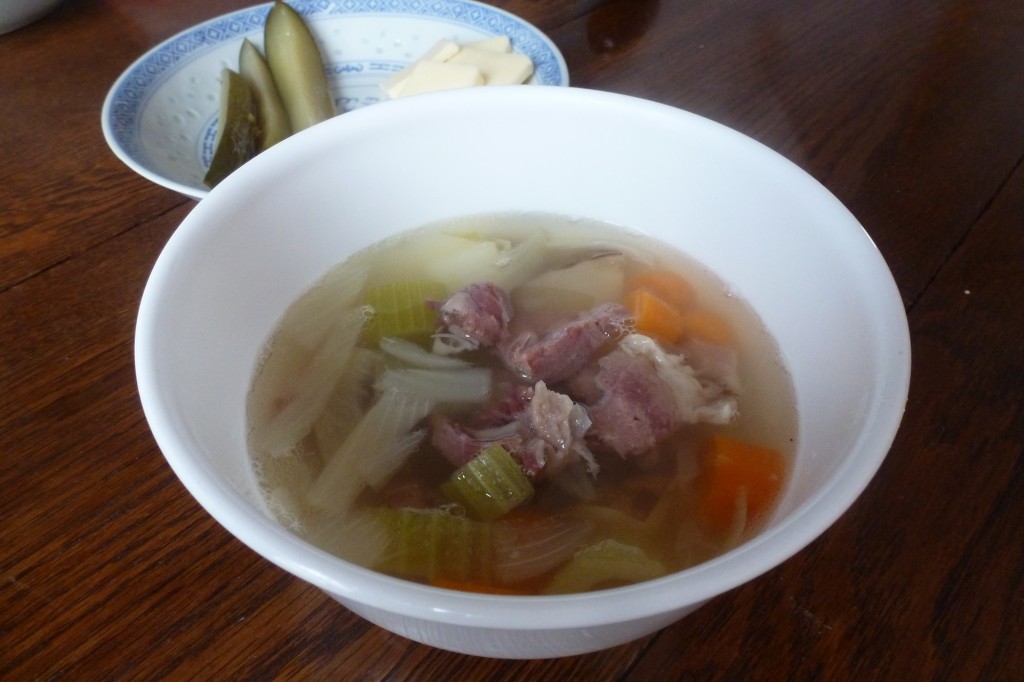 Traditionally, in North America the hock is a section of the front arm bone of the pig. On one end the elbow joint is severed. On the other, where the arm of the pig meats the body, a cut is made and the arm bone is sawed through. So on one end of the hock there is a clean joint, and on the other the circular cross-section of a bone.
Traditionally, in North America the hock is a section of the front arm bone of the pig. On one end the elbow joint is severed. On the other, where the arm of the pig meats the body, a cut is made and the arm bone is sawed through. So on one end of the hock there is a clean joint, and on the other the circular cross-section of a bone.
In traditional British butchery it is the analogous section from the hind leg that is called the hock; that from the front was known as the hand.
Nowadays, whether taken from the forearm or the hind leg, both cuts are considered hocks. They are almost always processed into ham, that is, brined and hot-smoked.
After three days in a curing brine I rinse and pat my hocks dry, then leave them overnight in my refrigerator on a wire rack, uncovered, to dry out the surface. The next day I hot-smoke them on my barbecue to an internal temperature of 65°C. Once cooled they are frozen for later use.
Following is a brief description of those later uses.
Hocks are an interesting cut of pork. The flesh is tough, and must be cooked low and slow to tenderize. As described above, they have a nice bone with an exposed joint. They also have a high skin-to-meat ratio.
They are prepared in only two ways in my house.
The first is simmering. If you simmer a smoked ham hock, you must consume every drop of the cooking liquid. Most or all of the smoke and cured pork flavour ends up in the broth, so to throw out the cooking liquid is a complete waste. You also get a good amount of gelatin from the bone, which gives the broth body. The meat can still be used, but it’s really only a garnish for the broth.
Ham Hock Soup
Throw the ham hock in a large pot of cold water. Or place it gently in a large pot of cold water. Bring to a boil, skimming away any foam that develops, then simmer gently until the hock is tender, maybe four hours. Remove the hock from the broth and add roughly chopped onions, carrots, celery stalk and root, turnips, potatoes, and garlic. Return the broth to a boil then simmer gently for another hour.
In the meantime, pull apart your hock. The skin is easily removed in one piece, and having been boiled for a few hours, it has been adequately rendered to either have the fat cut off the back and be ground for skin sausage, or simply be diced and served in a bean dish. Return the chunks of ham hock back to the broth.
Ladle the soup into deep, straight-sided bowls. Consume with stale bread, mustard, pickles, and cheese.
The second preparation is slow roasting. My culinary school text (Professional Cooking for Canadian Chefs) tells me that low heat and high moisture are the two environmental essentials to turn collagen into gelatin. As such, for tough cuts of meat like ham hocks, the book invariably recommends “moist-heat methods,” either simmering or braising. However, meat is about 75% water, and even when applying the “dry-heat” of, say a 300°F residential oven, there is adequate moisture to tenderize even the toughest cut of meat.
This is one of my favourite dishes of all time. By slow-roasting the ham hock you don’t leach any flavour into a surrounding liquid. The meat is tender, with a very unique, sticky, gelatinous quality. The skin becomes fantastic, glass-like crackling.
A roasted hock is a meal for two. Left-over bits of roasted hock meat are my second most favourite pieces of pork to have in my fridge, after bacon but before conventional ham. They make fantastic, flavourful, tender additions to eggs and starch dishes like macaroni.
Roast ham hock (or stelze) is a classic Bavarian beer hall dish. Below is pictured just such a hock, served with mashed apples and potatoes (himmel und erd[1]) and braised cabbage with bacon.
Roast Ham Hock
Put the ham hock on a wire rack on a sheet pan. Cook in a 300°F oven until tender, maybe four hours.
Once the meat is tender, raise the oven temperature to 450°F and cook until the skin is very crisp, maybe forty five minutes.
1. I decided to footnote this explanation because it is pretty long-winded. Himmel und Erde literally means “heaven and earth.” You know how the French call potatoes pommes de terre (“earth apples”)? Well, the Bavarians and Austrians kind of do the same thing. In Hamburg potatoes are called kartoffeln, but in Munich and Salzburg they are called erdaepfel, or “earth apples.” The dish “heaven and earth” is comprised of “heaven apples” (the red fruit that grows on tree tops) and “earth apples” (potatoes).
That’s not the only charming reference to heaven and earth in the Austro-Bavarian kitchen. Raspberries, which grow on vertical canes are called himmelbeeren, “heaven berries,” while strawberries, which grow on low-lying stems are called erdbeeren, “earth berries.”

